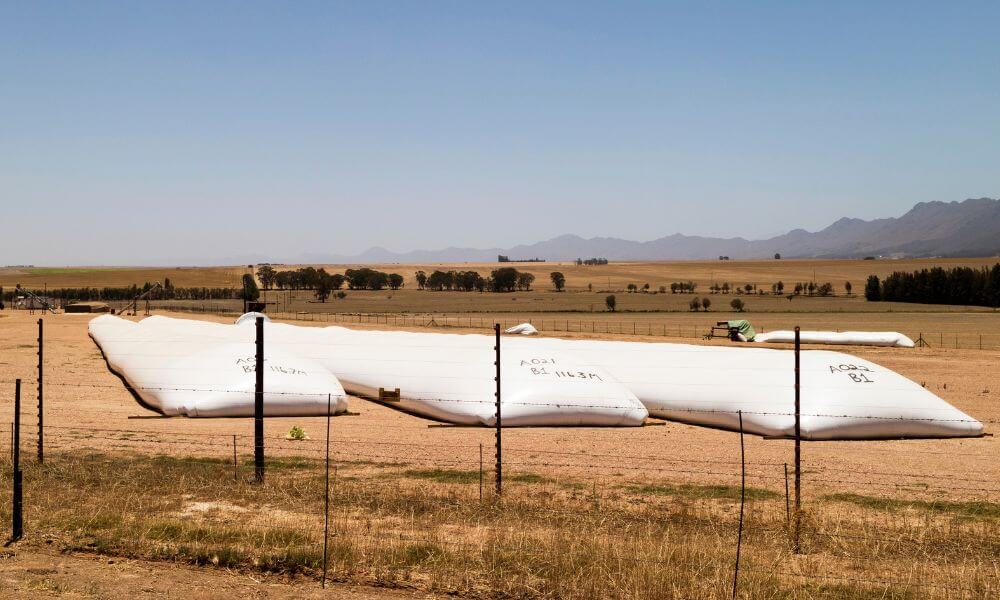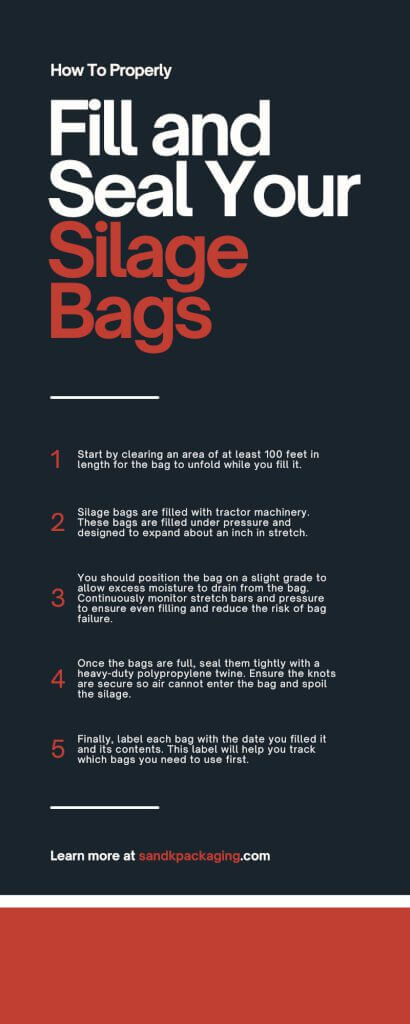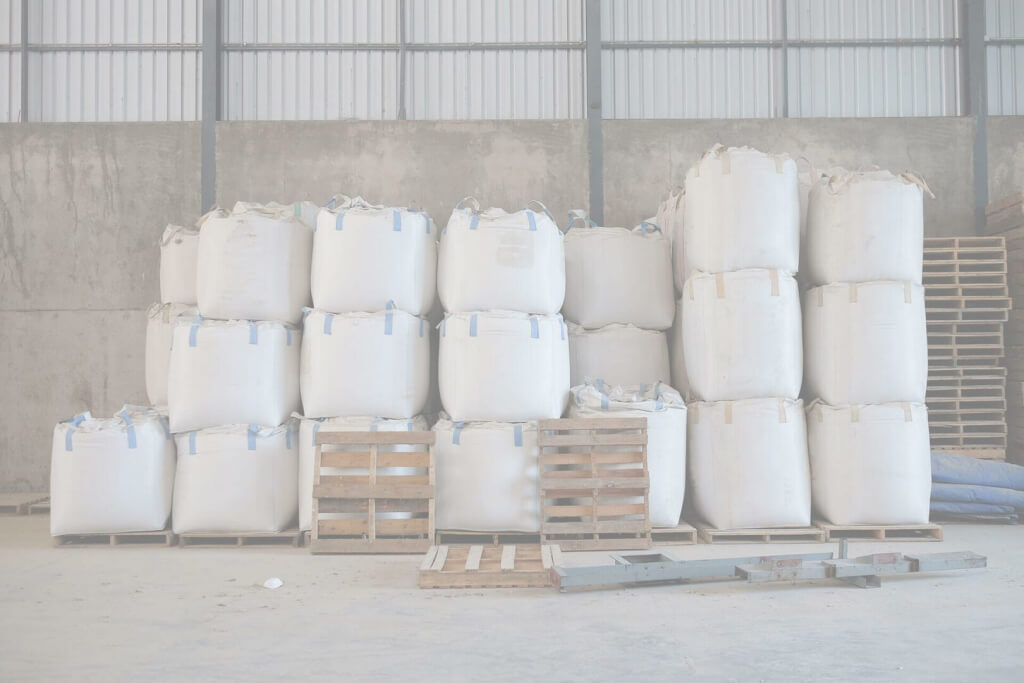
Every year, silage—a type of animal feed made from fermented, high-moisture stored crops—must be made to ensure adequate food supply for livestock. One of the most important steps in this process is properly filling and sealing your silage bags.
If done correctly, your silage will be adequately preserved and last through the entire winter season. Learning how to fill and seal your silage bags correctly can help you save time and money and prevent wasted feed.
How To Fill Your Silage Bags: A Step-by-Step Guide
- Start by clearing an area of at least 100 feet in length for the bag to unfold while you fill it.
- Silage bags are filled with tractor machinery. These bags are filled under pressure and designed to expand about an inch in stretch.
- You should position the bag on a slight grade to allow excess moisture to drain from the bag. Continuously monitor stretch bars and pressure to ensure even filling and reduce the risk of bag failure.
- Once the bags are full, seal them tightly with a heavy-duty polypropylene twine. Ensure the knots are secure so air cannot enter the bag and spoil the silage.
- Finally, label each bag with the date you filled it and its contents. This label will help you track which bags you need to use first.
Uses and Benefits of Silage Bags
Most people use silage bags to store feed for their livestock or grains for their animals. These bags keep food fresh for your livestock, and because they are airtight and water-resistant, they also keep pests and mold away.
Improving silage feed value is one of the main benefits of using these bags. When crop residues are left in the field, they can be subject to leaching, which decreases their nutritional value. On the other hand, bagged silage is protected from leaching and maintains its high nutritional content.
Another benefit of silage bags is they help you save money. Bagged silage is less likely to spoil than unpackaged silage, so you can store it for longer periods of time. This reduced spoilage means you won’t have to buy new feed as often, which can save you a significant amount of money over time.
Tips To Fill Your Silage Bags
To ensure your silage is of the highest quality, follow these tips when filling your bags.
Use High-quality Forage
The better the forage going into the bag, the better the silage quality. Be sure to use only fresh, high-quality forage in your bags. Avoid using forage that is moldy, wilted, or otherwise contaminated.
Fill Bags When Forage is at Peak Nutritional Value
You should fill forage when it is at its peak nutritional value—typically just before or during the boot stage of growth. Fill bags early in the morning or late in the evening to avoid heat damage to the forage.
Use an Appropriate Forage-to-Moisture Ratio
The forage-to-moisture ratio is important to consider when filling your bags. The ideal ratio is 60:40—60 percent forage and 40 percent moisture. Too much moisture can lead to clogging and anaerobic conditions, while too little moisture can result in dry, unpalatable silage.
Considerations When Filling Your Silage Bags
Farmers, ranchers, and other agricultural professionals use silage bags to store feed for their livestock. If you’re planning on filling your own bags, you should keep a few things in mind.
Choose the Right Size Bag
The size of the bag you use will depend on the amount of forage you have to store. Smaller bags are easier to handle, but you must fill them more often. Larger bags will hold more forage, but they can be more difficult to seal properly.
Seal Bags Properly
It is important to seal your bags tightly to prevent air from entering and spoiling the silage. Be sure to use a heavy-duty polypropylene twine and make secure knots.
Label Bags With Contents and Date
Labeling your bags with the contents and dates will help you track which ones you need to use first. This labeling is especially important if you store more than one type of forage in your bags.
Things You Should Know Before Buying Silage Bags
When buying a silage bale wrap, you should keep a few things in mind to ensure you are getting the best possible product.
Bag Material Matters
The bag’s material is important to consider because it will affect the shelf life of the silage. Low-density polyethylene (LDPE) is the most common and primary material for silage bags. S&K Packaging incorporates LLDPE (linear low-density polyethylene), LDPE, and nylon to maximize material strength and quality.
Bag Quality Matters
The quality of the bag you choose will also affect the shelf life of the silage. Be sure to select a high-quality bag made of durable materials. Avoid cheap, flimsy bags that are more likely to rip or tear.
What You’re Storing Matters
When storing silage, you should keep in mind what you are storing and its purpose. If you are storing feed for livestock, you should choose a bag that works for that purpose. Bags not meant for storing feed may not have the proper features, such as airtight seals, necessary to keep the silage fresh.
Making silage is an important part of ensuring a food supply for livestock over the winter months. Properly filling and sealing your silage bags is crucial to preserving your silage and ensuring it will last through winter storage conditions.
Following the steps outlined in this blog post, you can be sure your silage will get adequate protection against spoilage caused by oxygen exposure.
S&K Packaging can provide high-quality silage bags that are perfect for storing your winter feed supply. Whether you need a small or a large bag, we have the ideal size to fit your needs.
Our silage bags are a durable multi-layer material that will withstand winter storage. Contact us today to learn more about our products and how we can help you preserve your forage.


